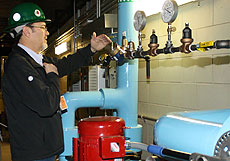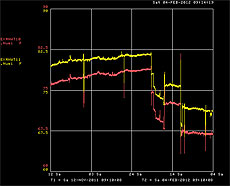Hot Fermilab experiments: Cooling system is a success

Lee Hammond checks the dials on the new cooling system for the MINOS underground area.
In 2009, after experimenters in the MINOS underground area expressed concern over a gradual increase in temperatures in the tunnel, Fermilab engineers went to work on a clever, yet tricky plan to rebuild the aging cooling system.
By adding two new chiller units and replacing the groundwater-based system with a recirculating loop of chilled water, the air temperatures would drop from the mid-80s to a breezy 68 degrees – optimal for these highly sensitive detectors. In the seven years since MINOS began taking data, minerals collected from the groundwater gradually clogged the filters and pipes, resulting in countless maintenance hours along with the reduced water pressure. The system struggled with a water flow reduced by half.
"We're watching these temperatures and seeing it just get warmer and warmer down there. And at 80 degrees the scintillator is just getting baked," said Debbie Harris, co-spokesperson for MINERvA. "That's the heart and guts of both the MINOS detector and the MINERvA detector."
Hotter scintillators age quicker, producing less light as particles pass through and hampering the detectors. Hotter electronics are compromised as well and are more likely to fail.
Much of this heat is generated by the MINOS coil. Another heat source requiring constant cooling is the hadron absorber, a concrete and metal enclosure that filters out everything but the neutrinos and muons from the beamline. With seven experiments housed in or visiting the underground area in recent years and with the development of NOvA, the rising heat had to be restrained.

The red line is the chilled water supply temperature (F), and the yellow line is the temperature of the returned water.
"We needed something better. And that something better was what Lee Hammond designed," Harris said.
Lee Hammond, FESS, and installation coordinator Mike Andrews, AD, collaborated with the separate experiments, while aggregating funding from the Particle Physics Division, the Accelerator Division, NOvA and a portion left over from the MINERvA project. Ron Foutch, FESS, and Dave Featherston, PPD, meanwhile, managed field construction with several contractors. The efficient work of Voris Mechanical, an independent contractor new to Fermilab, gained special praise from Hammond and Andrews.
The next hurdle for the team was timing the installation of the cooling system with the accelerator shut down schedule to avoid any disruption in beam delivery or data collection by the detectors.
"When everything was done, we went down there and were able to transfer everything onto the closed-loop system while we were running beam and [the experimenters] didn't see it," Andrews said. "All they saw was the water temperature going down."
Gradually the cooling system will dispel heat radiating from the surrounding rock and ground, which had been heating up over the last seven years. Three weeks with the new system and the MINOS Hall is already cooler than expected.
"Lee and Mike – those guys are really the two heroes here. They stuck with it and kept pushing. And they are the ones we had the party for," Harris said during a celebratory toast at the completion of the project.
—Brad Hooker |